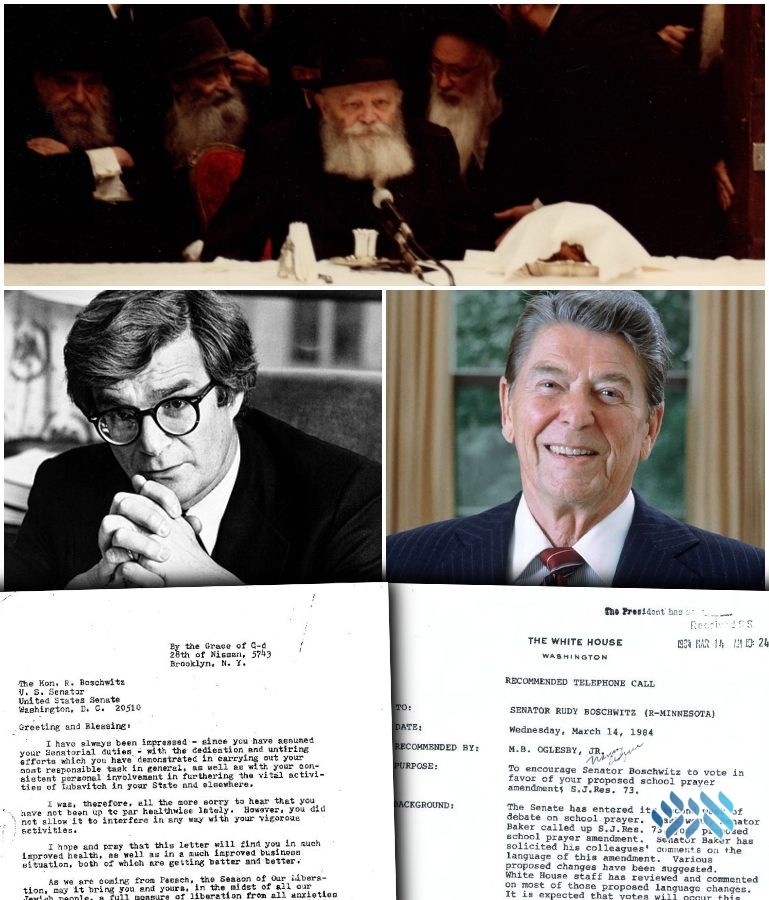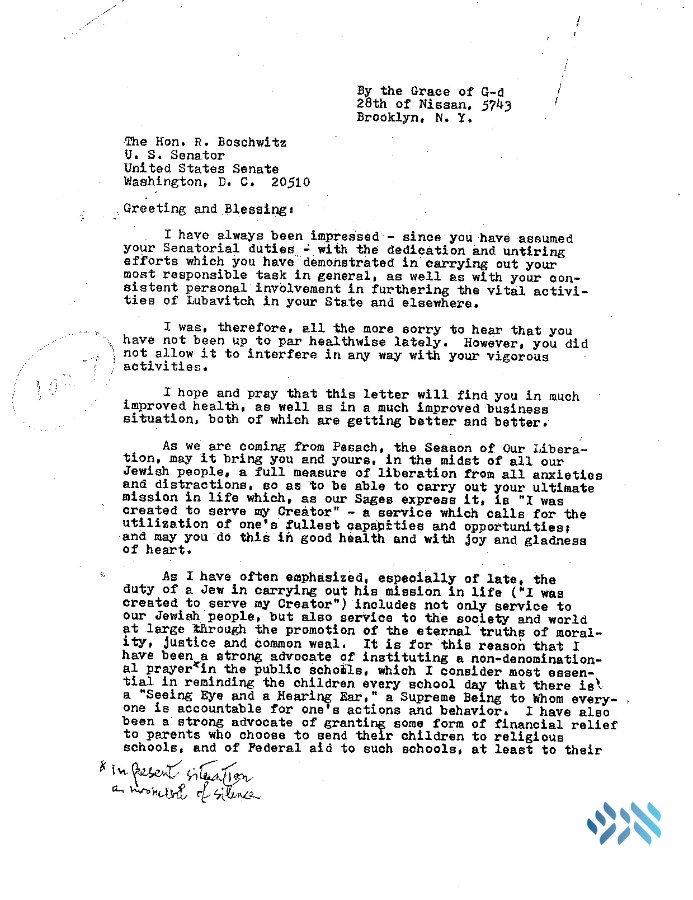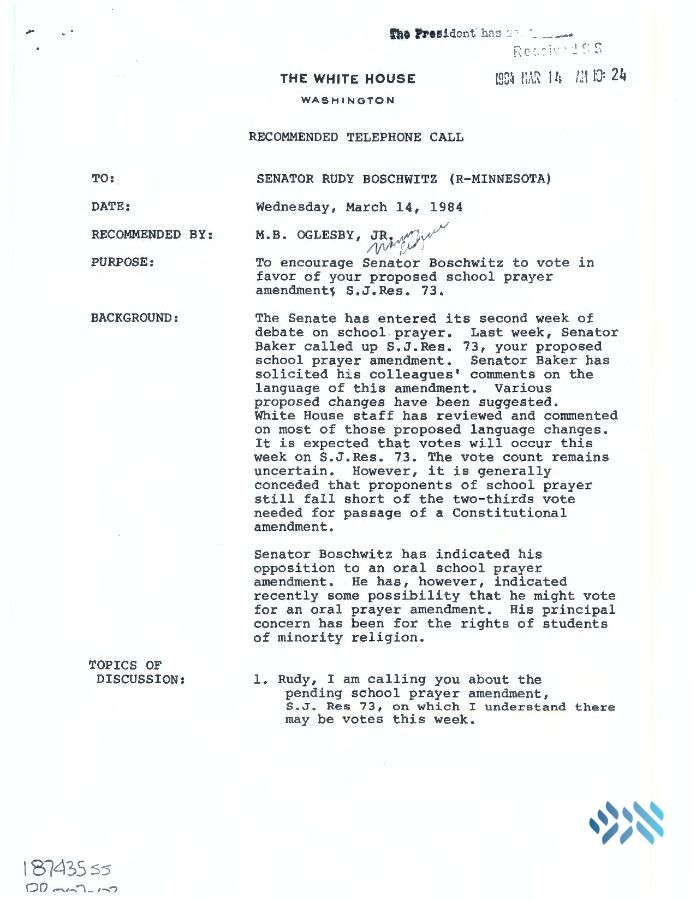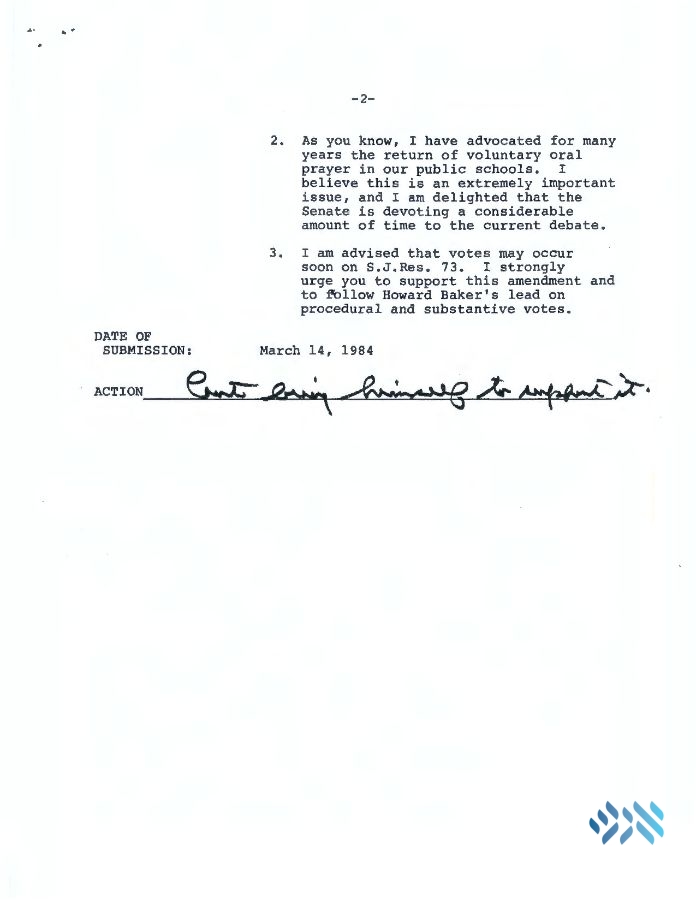In honor of the Rebbe’s birthday, a project has been launched to actualize the Rebbe’s vision for a non-denominational prayer in American public schools. We sat down with the organizers to find out what the Rebbe said about it and why now is the time.
By Anash.org reporter
In honor of the Rebbe’s birthday, a project has been launched to actualize the Rebbe’s vision for a non-denominational prayer in American public schools. The new project, called “Heal the Nation,” is set to make this a reality. To find out more, we sat down with the organizers to find out what the Rebbe said about it and why now is the time.
Anash Reporter: Hi! Let’s start from the beginning: What is a “non-denominational prayer” and why is it something the Rebbe felt strongly about?
Heal the Nation: Hi! A non-denominational prayer is a prayer to the Almighty that is universal. It doesn’t represent one particular religion, rather it is a general prayer that can apply to anyone.
In 1950, the New York State “Board of Regents,” which is responsible for all school standards in New York State, wanted to incorporate morals into public schools. They created a committee of Jews and non-Jews to establish a moral awareness for students in public schools.
The committee came up with a 26-word non-denominational prayer that was distributed to every school in New York State and offered to local school boards if they wanted to implement it. The prayer went like this:
“Almighty God, we acknowledge our dependence upon Thee, and we beg Thy blessings upon us, our parents, our teachers and our country. Amen.”
AR: What happened with that prayer?
HTN: That prayer was unfortunately discontinued in 1961, just 11 years after it was instituted. At that time, five parents of public school students in New Hyde Park sued the school president, saying that they were atheists and shouldn’t be coerced into saying a prayer at public school. Steven Engel, incidentally a Jewish parent, became the named plaintiff in the case of Engel v. Vitale, who argued that the prayer went against the First Amendment.
The case went all the way up to the Supreme Court where it was ruled that having a state-mandated prayer was unconstitutional. By the time the ruling came out, it was already the summer of 1962.
AR: What was the Rebbe’s view on the case and the ruling that followed?
HTN: The Rebbe addressed it three weeks later, at the farbrengen of Yud Gimmel Tammuz 5722 (1962). The Rebbe spoke passionately and said that the ruling is tragic since it takes away the concept of an Almighty Creator from the children.
In a letter written in Cheshvan of 5723 (November 1962), five months after the ruling was announced, the Rebbe penned a list with multiple reasons why it is so important to have the non-denominational prayer reinstated in schools across America. These include: many Yidden in public school who would get the chance to fulfill the mitzva of tefilla each day, the responsibility of teaching non-Jews Sheva Mitzvos B’nei Noach which includes first and foremost the belief in Hashem, and eradicating the name of Hashem from all schools is a blatant chilul Hashem.
The Rebbe then strongly encouraged every observant Jew to do anything they could to reinstate the prayer and reverse the Engel v. Vitale ruling. In the Rebbe’s words: “From every aspect of Jewish Law, it would appear clear that every Jew, for whom the Torah is a guide, is duty bound to use every legal and constitutional means to see the majority-decision of the Supreme Court on the Regents Prayer reversed.”
The Rebbe then spoke that efforts should be made to get an amendment to the constitution to bypass the ruling. In 1964, the recipient of the above letter wrote to the Rebbe that there were religious goyim who were trying to get a religious prayer approved by Congress. The Rebbe responded that that is precisely why he wants that frum Yidden to get involved: to make sure that a non-denominational prayer is pushed, and not a religious prayer that would be against Yiddishkeit.
AR: What was the response of the Jewish community in America to the ruling?
HTN: Most Jewish leaders at the time were of the opinion that Jews in America should not get involved. They didn’t want to get involved in issues pertaining to the separation of church and state since they feared it would lead to negative encroachments in areas of Jewish practice.
The Rebbe, however, was not concerned about this. In a letter to a questioner, the Rebbe goes into depth eloquently explaining why the concerns about distorting the distinctions between church and state are irrelevant. The Rebbe also describes the deep impact that bringing Hashem into schools will have on the youth and how it will positively affect the students and protect them from further involvement in crime in the future. Everyone should read the letter in full.
In a recent interview, attorney Nat Lewin, who represented Chabad for public menorah lightings and the seforim case and clerked at the Supreme Court during Engle v. Vitale, said about the topic:
“I was, at that point, surprised because all the Jewish organizations had claimed that it was clearly unconstitutional to encourage people to recite this non-denominational prayer in New York public schools.
“Only the Lubavitcher Rebbe opposed the majority opinion of the Supreme Court and he sent out a letter saying that it was better that everybody should be praying to God and acknowledging their debt to the Almighty than that should be denied. And I appended his letter, many years later, in a brief that I filed in the Supreme Court of the United States. At the time, personally, I was surprised and frankly, I thought he probably was not right…
“And as I matured years later, I came to the realization that probably the Lubavitcher Rebbe was right. It’s better that everybody acknowledges God. Just as the words ‘under God’ now appear in the Pledge of Allegiance, I now think it would be a better America if everybody recognized that we live under God and we acknowledge our debt to the Almighty.”
AR: What happened after the court ruling came out in 1962? Were there any further developments in this regard?
HTN: Yes. In 1982, President Ronald Reagan began pushing for an amendment that would allow for a prayer to be recited in school, and the content would be left up for each child to decide.
The Rebbe vehemently opposed that proposal out of concern that if it is left up to the students in each classroom, non-Jews would introduce Christian prayers causing a detrimental effect on the Jewish children. (Incidentally, while discussing this point in Congress, one senator shared a letter from a Jewish boy of his own experience to this effect.)
That same year, Rebbe then began to promote the solution of the famed ‘Moment of Silence’ that would encourage students to think about a Greater Being during a brief moment at the start of the day. The Rebbe spoke about the ‘Moment of Silence’ at the Yud Shvat farbrengen, the children’s rally on Chol Hamoed Pesach, and at Moshiach’s Seuda on Acharon Shel Pesach.
It is worth noting that the concept of a ‘Moment of Silence’ was not invented by the Rebbe; it existed in New York State since 1971. Yet, as long as a non-denominational prayer was on the table, that was the preference. However, once the government wanted to allow students to recite their own religious prayer, the Rebbe began pushing for a non-verbal meditation that would not carry the threat of Jewish children being exposed to Christian prayers.
AR: So the Rebbe mainly advocated for introducing a non-denominational prayer in schools, and only once there was the proposal for a constitutional amendment to allow students to independently compose their own verbal prayers, did the Rebbe advocate for a ‘Moment of Silence’?
HTN: Yes.
The fact that a Moment of Silence was only a temporary fix and the Rebbe hoped to bring back a non-denominational prayer is evident from the Rebbe’s handwritten note on a letter to Senator Rudy Boschwitz. The letter is dated 28 Nissan, 5743 (1983), after the Rebbe had been speaking about MOS for some time.
In the letter, the Rebbe writes, “I have been a strong advocate of instituting a non-denominational prayer in public schools, which I consider most essential in reminding the children every school day that there is a ‘Seeing Eye and Hearing Ear’ a Supreme Being to whom everyone is accountable for one’s actions and behavior.” And there, after the words ‘non-denominational prayer’ the Rebbe inserts an asterisk and adds in handwriting ‘*in present situation, a moment of silence.’
In other words, the Rebbe mainly advocated for a non-denominational prayer but resorted to a ‘Moment of Silence’ due to the current situation with Reagan’s prayer amendment.
Extensive research into the “present situation” that the Rebbe was referring to uncovered a script provided to President Reagan for a phone conversation with Senator Boschwitz. The president was trying to garner support for his amendment and was calling Boschwitz for his vote. Under that situation, it was necessary to move away from verbal prayer and replace it with a moment of silence.
Three years later, after 5746 (1986), the Rebbe stopped promoting a Moment of Silence, which makes a lot of sense, since the verbal religious prayer was no longer on the table.
AR: So what happened now that this is coming up again?
HTN: We are now in a unique political situation where it seems possible for a non-denominational prayer could be approved by the Supreme Court. This was confirmed by many political analysts, including the noted constitutional attorney Alan Dershowitz. Although not a fan of non-denominational prayer in public schools, he confirmed that it is “fairly good now” for the 1962 ruling to be reversed by the Supreme Court, if it were brought before them.
Besides the positive aspect of making the world more aware of Hashem, the non-denominational prayer also takes the place of something harmful. Just like with Reagan’s amendment for prayer, there are religious Christians who would like to install a problematic prayer. Case in point: Just recently, the US Supreme Court ruled in favor of a public high school football coach’s Christian prayer on the football field with the players (Kennedy v. Bremerton School District).
AR: How do you suggest to go about raising awareness about this?
HTN: We have created the website HealTheNation.us to begin the push to challenge the 1962 ruling and bring about this vision the Rebbe had for America for over 60 years. The website has a letter that Americans can generate with their governor and state representatives’ names and mail it to them. We have also produced a radio ad that encourages Americans to visit the site and reach out to their state politicians.
If you want to get involved you can reach us through the website for opportunities to move this project along, and of course, you can support the cause by donating on the donate page to allow the ad to reach more people.
AR: Thank you very much for sharing this information with our readers and may you have much success in implementing the Rebbe’s hope of spreading the awareness of Hashem among all!







Discussion
In keeping in line with the Rabbonim's policies for websites, we do not allow comments. However, our Rabbonim have approved of including input on articles of substance (Torah, history, memories etc.)
We appreciate your feedback. If you have any additional information to contribute to this article, it will be added below.